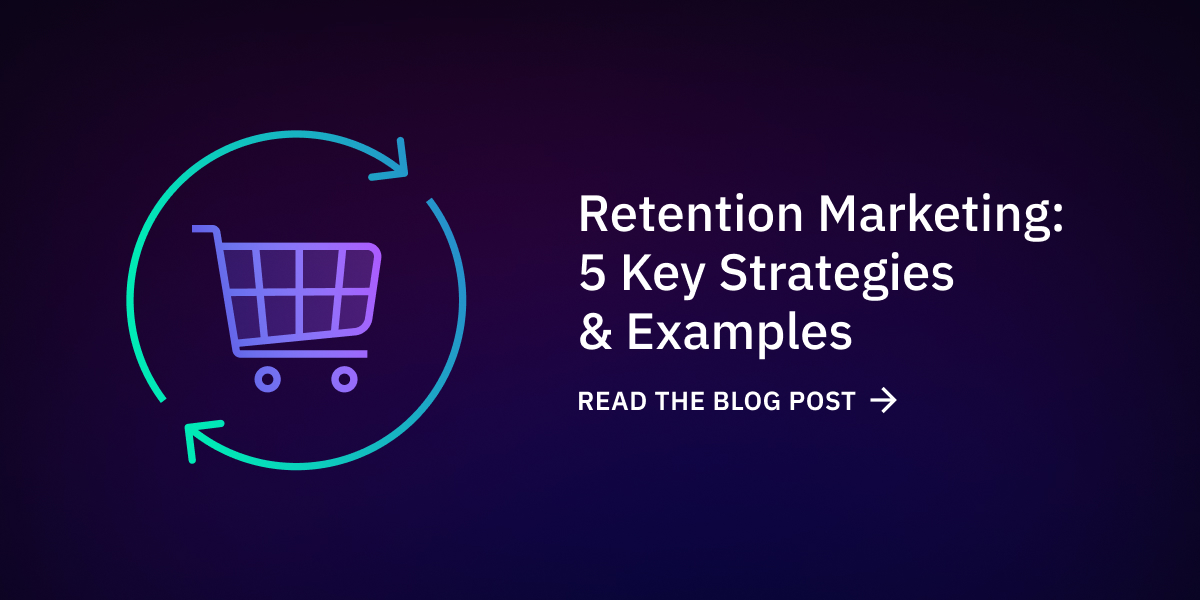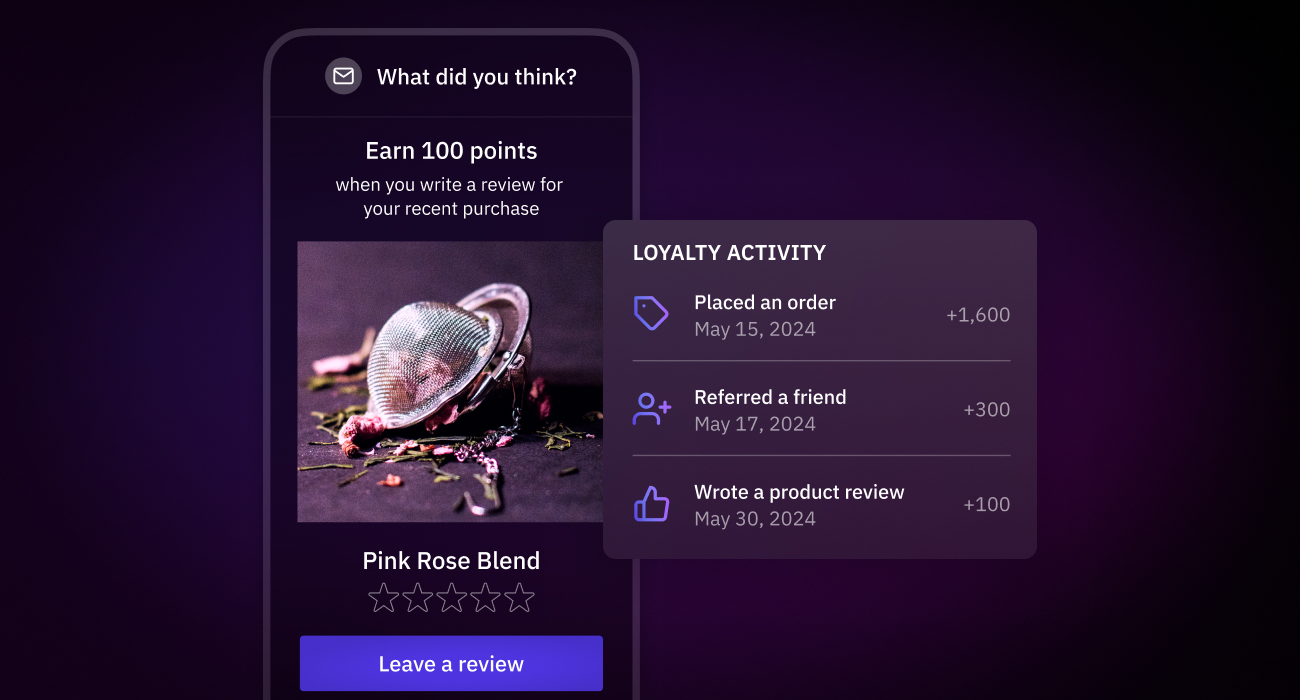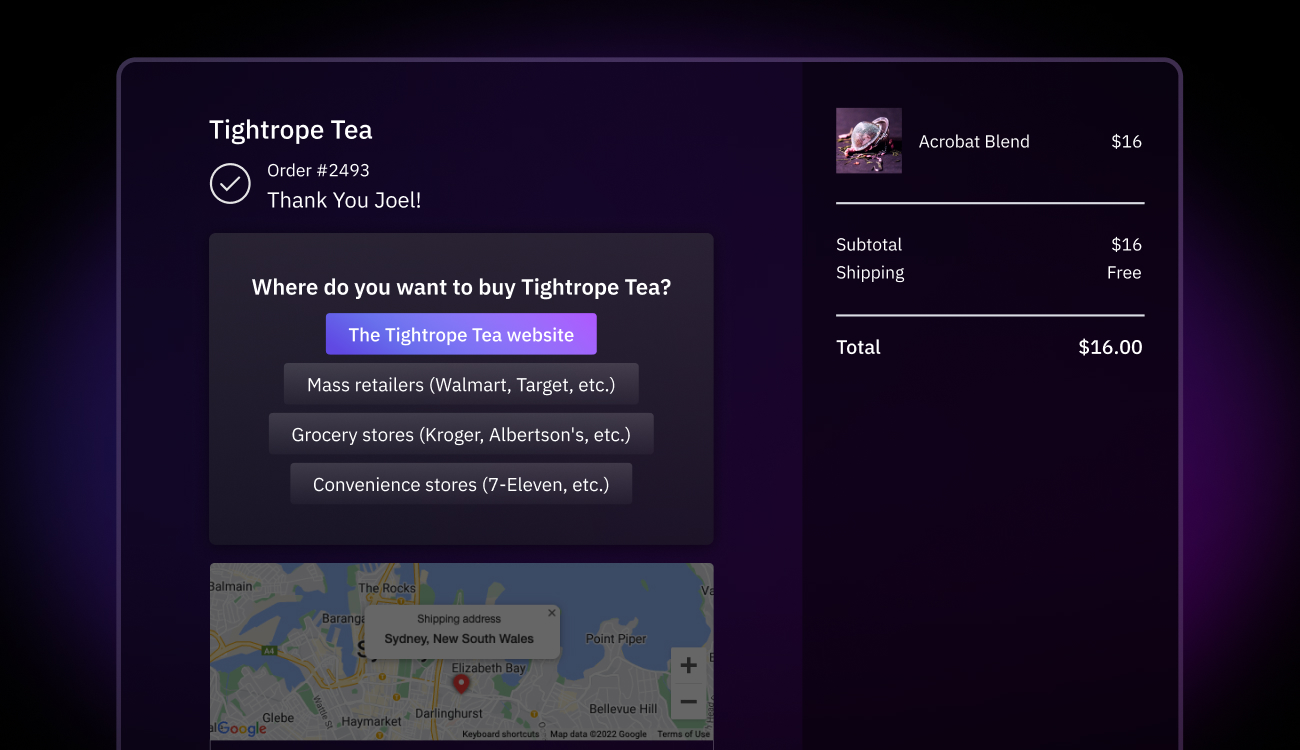What is Retention Marketing? 5 Key Strategies & Examples

Retention marketing focuses on nurturing existing customer relationships to encourage repeat purchases, enhance engagement, and gather valuable feedback. Effective strategies involve loyalty programs, post-purchase surveys, personalized discounts and offers, leveraging customer reviews, and quizzes. When working on retention marketing, brands should focus on understanding customers, delivering consistent value, encouraging feedback, and acting on insights to enhance the overall customer journey.
Retention marketing seems to be the buzzword circulating at industry conferences, trade shows, webinars, and even in brands’ internal discussions. While it’s far from a new concept, the somewhat sudden focus can leave brands wondering, why is it so important now?
With rising acquisition costs thanks to a challenging and eventful macro environment, brands are increasingly focused on serving existing customers rather than morphing strategies to acquire new customers. A retention marketing strategy helps brands rely less on customer acquisition and instead focus on how to optimize the current customer base for sustainable and continued growth even through tumultuous retail landscapes.
What is Retention Marketing?
Retention marketing operates on the idea that brands can benefit from nurturing relationships with existing customers rather than just focusing on bringing in new customers. It refers to any strategy that would encourage a previous customer to return and make repeat purchases, engage with your brand, or provide feedback or customer insights. It differs from customer acquisition marketing in its focus on the current customer, whereas acquisition marketing focuses on new customers who have not made purchases or engaged with your brand.
It is an effective tool for improving profitability, building loyalty, and standing out from the competition. The key metrics to focus on when evaluating retention marketing include retention rate, churn rate, and CLTV. These metrics are important to track and analyze when determining whether the strategies are effectively engaging existing customers. For more detailed information on how to measure retention, reference our guide How to Measure Customer Loyalty in 2024.
The Main Benefits of Retention Marketing
As Zac Fromson, COO of Tequila Sunrise says, “With new privacy updates and more people opting out of marketing tactics, the cost per reach has increased considerably in the last few years. That is why nurturing and keeping the folks you’ve acquired has become the top priority—customer retention will save you lots of money.”
To break it down, these benefits include increased customer lifetime value, improved customer satisfaction and loyalty, a more effective use of the marketing budget, and better customer insights and feedback.
Increased Customer Lifetime Value (CLTV)
Retention marketing can effectively improve customer lifetime value thereby making your brand a go-to for your customer base. A higher CLTV means that customers return for repeat purchases thereby reducing marketing costs, providing valuable data and insights, boosting brand advocacy and loyalty, and ultimately generating better profitability.
A higher customer lifetime value also has a halo effect on customer acquisition. More customers returning for repeat purchases means more potential for social proof, user-generated content, brand advocacy, and coveted word-of-mouth advertising. Retention marketing might focus on existing customers, but customers can also be acquired through these efforts when executed effectively.
Improved Customer Satisfaction and Loyalty
With a greater emphasis on retention marketing, brands show their existing customers that they care about the customer experience and want to foster a strong relationship with their audience. Retention marketing strategies often involve requesting feedback, providing incentives for repeat purchases, or offering exclusive perks—all of which improve customer satisfaction and encourage loyalty.
This helps brands create a pathway for sustainable growth. Loyal customers are less costly to the marketing budget, can help the brand prosper during difficult economic times, and can potentially help acquire new customers through brand advocacy.

More Effective Use of Marketing Budget
Marketers universally understand that retaining existing customers is much more cost-effective than acquiring new customers. New customers have not experienced your brand’s offering, so getting them past their initial skepticism and hesitancy can be very costly on the marketing budget. Existing customers, however, have already had at least one prior experience with the brand. So they are naturally less apprehensive and your brand has at least some data or insights into how they shop, what piques their interest, and what marketing strategies worked on them in the past. With more marketing spend allocated to retention marketing, brands can effectively optimize their budgets to focus on customers most likely to make a purchase.
Focusing on customer retention marketing can also build brand resilience and conserve budgets for rainy days. When cost per acquisition naturally rises from the macro environment (think election years, the Olympics, and supply chain issues), your brand will be less affected.
Better Customer Insights and Feedback
Inviting existing customers to make repeat purchases and provide feedback is like retaining a brand consultant without the consultation fees. Customers who have purchased in the past are familiar with your product, customer experience, and service and are therefore much more able to provide valuable insights. This allows you to hone your product offering, experience, or service to accommodate your most valuable, loyal customers.
A greater emphasis on retention marketing can also enhance the quality of customer feedback because, with each additional purchase, the customer becomes more familiar and can provide more genuine and specific feedback. A first-time, newly acquired customer might see your brand through rose-colored glasses, but a veteran customer will be more familiar with the quirks and shortfalls that could cost your brand in the long run.
5 Key Retention Marketing Strategies
To effectively nurture your brand’s relationship with its existing customers, you must employ effective strategies. These five methods can be used to enhance customer loyalty and drive retention.
1. Loyalty Programs
With a loyalty program, brands can reward customers who complete specific behaviors with perks, discounts, or other incentives. Loyalty programs often have a points-based system that allows customers to move up into higher VIP loyalty tiers for better rewards, exclusive offers, deeper discounts, or additional benefits.
From the brand perspective, loyalty programs are a simple, systematic way to encourage loyalty, increase repeat purchases, improve retention rates, reduce costs, and gather customer data and insights. From the customer perspective, they provide structure to the shopping experience, ensure brand accountability, increase the ways to engage with favorite brands, gamify the points-earning process, and provide an opportunity to be heard and understood. According to loyalty program research by Okendo, 77% of consumers say they are more likely to remain loyal to a brand long-term if it offers a compelling loyalty program.
2. Post-Purchase Surveys
One of the elements of an effective retention marketing strategy is showing customers that the brand cares about their experience and will make efforts for continued improvement. This is easily achieved through the employment of post-purchase surveys.
Post-purchase surveys invite customers to share feedback about their experience after the point of sale to best capture the full, comprehensive shopping experience. They are an effective tool for collecting data and helping brands concentrate efforts on the most important stages of the customer journey and for connecting customers and demonstrating that their feedback matters.

3. Personalized Discounts and Referrals
Personalized discounts and referrals create a tailored experience for each customer to not only make them feel special but also increase marketing campaign effectiveness. When geared toward the appropriate audiences, they are much more likely to generate sales, boost retention rates, and create a positive customer experience.
Brands can personalize referrals and discounts based on customer behavior. For example, a customer who is likely to spend lower than a brand’s free shipping threshold can receive a free shipping offer code whereas a customer likely to have a higher AOV can receive an order discount percentage code. Offering promotions that are relevant and appealing to customers on an individual basis will increase redemption and thereby retention rate.
For the most effective personalization efforts, customer data must live in a program that seamlessly integrates well with other programs and creates a unified customer profile. Accurate information is key to ensuring that personalized experiences don’t miss the mark and make offers that are irrelevant or to the wrong audience.
4. Leverage Customer Reviews
By leveraging customer reviews, brands can harvest customer feedback, utilize user-generated content for advertising and social proof, and reassure existing customers in their purchasing decisions. When customers see a product that has many high-quality reviews or is top-rated, they are much more likely to believe that it is a worthwhile product to purchase.
Customer reviews also add a layer of authenticity to your product pages or UGC-based advertisements. Whether the reviews are positive or negative, displaying feedback shows that the brand is being honest, feels confident in the product offering, and does not censor customer opinions. This lets customers feel that not only are the product claims verifiable by other existing customers but also that the brand is trustworthy.
Brands can send automated emails to customers requesting a review post-purchase. Oftentimes these review requests offer a small discount in exchange for the customer’s feedback. These emails also have the added benefit of getting customers to the site a second time to write a review (and possibly make a repeat purchase).
5. Quizzes
Providing an engaging and personalized experience is one of the few perks a brand can offer that does not involve a discount, marketing spend, time-intensive effort, or a drain on margins. Product recommendation quizzes provide customers with entertainment, product knowledge, value-packed content, and self-paced engagement with the brand.
When executed correctly, quizzes can increase customer retention with an engaging and informative customer experience. Since quizzes are voluntary, the data is zero-party, allowing the brand to build a foundation of trust with customers and bypass privacy concerns from third-party data. Customers will expect retention campaigns or marketing strategies based on the results of the quiz and see them as helpful and genuine rather than invasive and bothersome.
Best Practices for Retention Marketing
When focusing on retention marketing, brands should focus on understanding customers, delivering consistent value, and encouraging customer feedback. Each of these are invaluable practices for an effective strategy.
Understand Your Customers
Collecting and analyzing customer data is imperative for forming a comprehensive and successful retention marketing strategy. With thorough data analysis, you can find the best time to request customer feedback, the most enticing products or offers, when customers are most likely to make repeat purchases, and any pain points or friction in the shopping experience that would preclude repeat purchases or customer loyalty. Instead of cookie-cutter strategies and one-size-fits-all marketing, data analysis lets you break your customers into segments by similar attributes and also personalize communications and experiences or product offerings.
Deliver Consistent Experiences
Offering consistent experiences across all customer touchpoints and keeping customers in the loop is essential to success. Existing customers have an initial impression of your brand and are basing their opinions on prior experiences. It follows that when changes are made, features and benefits are added, or strategies have been adjusted, existing customers are the cohort that would be the most important to notify.
Further, delivering consistent value is important in responding to feedback and making continuous improvements. If customers take the time to write a review, fill out a survey, or reach out to customer service, an effective retention marketing strategy would require tracking and regularly filling the customer in on the progress being made.
Encourage Customer Feedback
Customer feedback should be valued, prioritized, and treated with care. While acquiring new customers and getting them to complete a purchase is challenging and costly, requesting and receiving a review or survey response is perhaps even more difficult. Not only does customer feedback encourage future customers to trust your brand, but it also helps your teams hone the customer experience, make improvements, focus on the most important pain points, and ultimately improve ecommerce conversion rate and loyalty.
Surveys and reviews are the most common method for gathering and encouraging customer feedback. When responses are received, the top priority should be responding to feedback to let the customer know that they have been heard. Instead of just placating customers, however, ensure that your brand actions this feedback and makes conscious steps to address the customer’s concerns.
Ecommerce Retention Marketing Examples
These two brands have successfully implemented retention marketing strategies with the use of Okendo’s suite of products.
Example 1: How Jordan Craig Achieved 59x ROI
Jordan Craig sought to improve their 40% repeat purchase rate by implementing a loyalty program with Okendo. By using Okendo Loyalty to segment their customer base, create a rewards system based on clout (early access to sales and exclusive offers) rather than points, and set up tiers in line with its brand image, Jordan Craig was able to increase AOV by 12% and achieve a 4% program enrollment rate.
Example 2: How Dreamland Baby Increased Customer Engagement
Dreamland Baby implemented Okendo Quizzes and Okendo Reviews to best serve their existing customers and encourage customer feedback on their products. Dreamland Baby is a baby supply brand that previously had trouble driving customer traffic to categories other than their best sellers. With Quizzes, they were able to create an engaging and personalized experience that helped customers discover more of the brand’s product offerings while simultaneously allowing the brand to collect valuable customer data. Quizzes also allowed Dreamland Baby to create a community of Superfans who offer parenting advice to each other via reviews thereby creating customer loyalty and engagement.
Leverage Okendo for Effective Retention Marketing
With Okendo’s customer marketing platform, your brand can create a comprehensive retention marketing strategy that helps you understand your customers, deliver consistent value, and leverage customer feedback to create an excellent online shopping experience. Welcome existing customers back to make repeat purchases with Okendo Reviews, Referrals, Loyalty, Surveys, and Quizzes and see the benefits of an intuitive, seamless, and effective retention marketing strategy.
Conclusion
Retention marketing not only improves brand image, boosts loyalty, and creates a positive customer experience, but it also cuts marketing costs, improves profitability, and allows for continued improvements and enhancements to the end-to-end customer experience. It’s a valuable tool for brands to focus on their best customers and delve into how best to accommodate their preferences, respond to their feedback, prioritize their experience, and create meaningful brand-to-customer interactions for sustainable and long-term relationships.